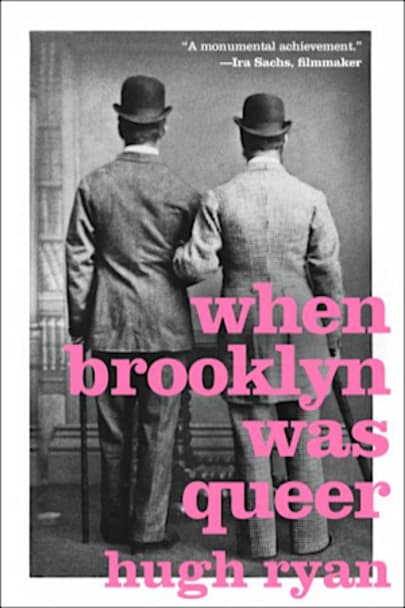The never-before-told story of Brooklyn’s vibrant and forgotten queer history, from the mid-1850s up to the present day. ***An ALA GLBT Round Table Over the Rainbow 2019 Top Ten Selection*** ***NAMED ONE OF THE BEST LGBTQ BOOKS OF 2019 by Harper’s Bazaar*** “A romantic, exquisite history of gay culture.” –Kirkus Reviews, starred “[A] boisterous, motley new history…entertaining and … motley new history…entertaining and insightful.” —The New York Times Book Review
Hugh Ryan’s When Brooklyn Was Queer is a groundbreaking exploration of the LGBT history of Brooklyn, from the early days of Walt Whitman in the 1850s up through the queer women who worked at the Brooklyn Navy Yard during World War II, and beyond. No other book, movie, or exhibition has ever told this sweeping story. Not only has Brooklyn always lived in the shadow of queer Manhattan neighborhoods like Greenwich Village and Harlem, but there has also been a systematic erasure of its queer history–a great forgetting.
Ryan is here to unearth that history for the first time. In intimate, evocative, moving prose he discusses in new light the fundamental questions of what history is, who tells it, and how we can only make sense of ourselves through its retelling; and shows how the formation of the Brooklyn we know today is inextricably linked to the stories of the incredible people who created its diverse neighborhoods and cultures. Through them, When Brooklyn Was Queer brings Brooklyn’s queer past to life, and claims its place as a modern classic.
more



I really enjoyed this book a lot and learned quite a bit about the borough of my birth. Growing up in Brooklyn in the late 1960s-1980s, there were a lot of things that I didn’t have social context for, the lack of queer community in the area being one of them. This is a book that sets a high standard for community histories and if you are interested in the history of queer communities, the cultural history of America cities and/or urban planning, for that matter, this is definitely one for your reading list. The writing is clear and engaging too and I look forward to reading more books by this author.
When Brooklyn Was Queer is a treasure for anyone who wants to look deeper, who wishes to better understand the city and its history, for anyone who walks through Brooklyn and sometimes feels the ghost of history. Spanning centuries, neighborhoods, races and classes, this is an ever fascinating story of the inventive, fascinating, striving, hustling and romantic queers who made and make Brooklyn the magical, heartbreaking place of promise.
With meticulous research and fierce compassion, Hugh Ryan brings stories and communities almost lost to history to vivid life. Ryan’s brilliant work is a thrilling portrait of the endurance, resourcefulness, and indefatigable joy queer people brought to bear upon the challenge of their own survival. This is an essential book, and I’m more grateful to it than I can say.
Tender, compelling, fascinating ― Hugh Ryan is doing essential work here, bringing us stories of the lives we almost lost to time and gentrification, stories we need urgently, of the queer life that thrived before this moment. Ryan brings us back to a time before we had even the expectation of legal acceptance, and the lives people made as they could, and his interlocutor’s eye for where to look is, as ever, brave and unstinting.
Meticulous research and wonderfully skillful storytelling make Hugh Ryan’s book a revelation of queer history as well as a joy to read.
A delicious, fun, and moving study, cohered and popularized from generations of queer historians and deepened with new and exciting primary research. Hugh Ryan’s love for queer Brooklyn is page-turning, intersectional and an engrossing read.
Fascinating. Eye-opening. Brilliantly put together. History that very much deserves to be told.
I think the author did a wonderful job explaining complicated, nuanced issues like society’s evolving views on gender identity, sexual orientation, and even race. It was so enlightening to read how the contemporary mores and the changing scientific and psychological views of the times impacted queer people, as well as women and people of color of that period. I never realized before that queer people’s rights were actually threatened and constricted more with the passage of time, rather than less. Naively thinking that the further along the twentieth century, the better things got. Sadly, things got worse before they got better.
The book is built up through glimpses into the lives of several (presumed) queer people of that period which makes it even more gripping and poignant, because we have actual people, faces and names to put on these facts. I very much enjoyed all the photos throughout the book, they help so much in visualizing everything. I was quite happily surprised by how many the author was able to find.
I really enjoyed the writing style, which was incredibly informative and insightful, but never got too heavy or dry. Quite the opposite, in fact! I loved learning about Brooklyn’s queer history this way and I’ve highlighted numerous things along the way that I want to delve into deeper.
A wonderful read.